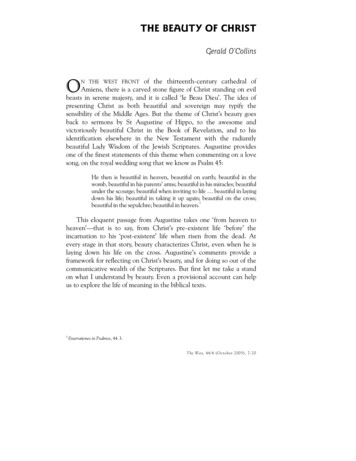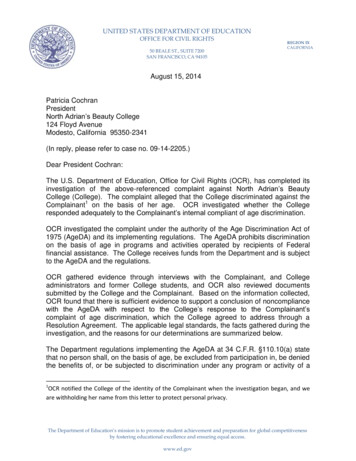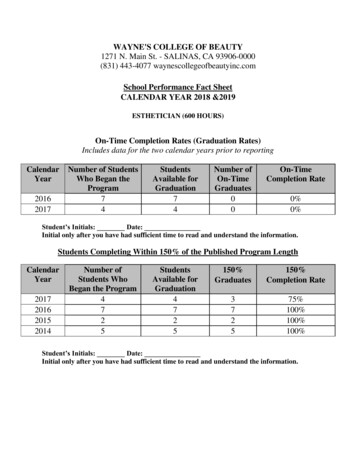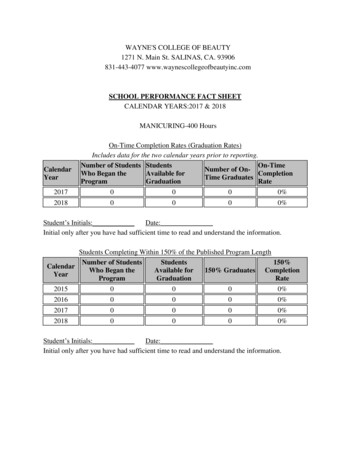
Transcription
THE BEAUTY OF CHRISTGerald O’CollinsON THE WEST FRONTof the thirteenth-century cathedral ofAmiens, there is a carved stone figure of Christ standing on evilbeasts in serene majesty, and it is called ‘le Beau Dieu’. The idea ofpresenting Christ as both beautiful and sovereign may typify thesensibility of the Middle Ages. But the theme of Christ’s beauty goesback to sermons by St Augustine of Hippo, to the awesome andvictoriously beautiful Christ in the Book of Revelation, and to hisidentification elsewhere in the New Testament with the radiantlybeautiful Lady Wisdom of the Jewish Scriptures. Augustine providesone of the finest statements of this theme when commenting on a lovesong, on the royal wedding song that we know as Psalm 45:He then is beautiful in heaven, beautiful on earth; beautiful in thewomb, beautiful in his parents’ arms; beautiful in his miracles; beautifulunder the scourge; beautiful when inviting to life beautiful in layingdown his life; beautiful in taking it up again; beautiful on the cross;1beautiful in the sepulchre; beautiful in heaven.This eloquent passage from Augustine takes one ‘from heaven toheaven’—that is to say, from Christ’s pre-existent life ‘before’ theincarnation to his ‘post-existent’ life when risen from the dead. Atevery stage in that story, beauty characterizes Christ, even when he islaying down his life on the cross. Augustine’s comments provide aframework for reflecting on Christ’s beauty, and for doing so out of thecommunicative wealth of the Scriptures. But first let me take a standon what I understand by beauty. Even a provisional account can helpus to explore the life of meaning in the biblical texts.1Enarrationes in Psalmos, 44. 3.The Way, 44/4 (October 2005), 7-20
8Gerald O’CollinsBeautyDrawing on St Thomas Aquinas, Jacques Maritain described beauty asfollows:For beauty three things are required: in the first place, integrity orperfection (integritas sive perfectio), for whatever is imperfect is eoipso ugly; in the second, proportion or harmony (proportio siveconsonantia); in the third, clarity (claritas), for there is a splendourin all objects that are called beautiful.2These three qualities of beauty—an exquisite flawlessness, aharmonious proportion, and a radiance—point to what we perceive inbeautiful objects. They have a proper completeness; they display aperfect shape and order; andthey enjoy a ‘luminosity’, orthe right balance of colourand light through which theystand out appropriately. Werejoice in the ‘radiant form’ ofsome person, or delight in the‘splendid’ performance of asymphony or a great drama.What I have just saidraises the crucial issue of participation in what is beautiful.Beauty attracts us, evokes ourwonder and joy, and arouses aflood of delight and inconsolable longing. We fall in lovewith beauty, sing its praises,and want to stay in its presence. When Solomon succumbs to the beauty of LadyWisdom, he wants to live withher forever: ‘When I enter myLe Beau Dieu, Amiens Cathedralhouse, I shall find rest with2Art and Scholasticism, translated by J. F. Scanlan (London: Sheed and Ward, 1930), 24-38, 159.
The Beauty of Christ9her; for companionship with her has no bitterness, and life with herhas no pain, but gladness and joy’ (Wisdom 8:16). At the same time,there is a mysterious quality to beauty which points beyond its merevisible expression, and leaves us asking: Where does that radiantloveliness come from, and why does it affect me in the way that itdoes? The mystery of beauty involves a depth of meaning which cannever be exhausted. The significance of a beautiful person, a greatpiece of music, or a radiant painting cannot be plumbed and expressedonce and for all, as the classic love poetry of the world has alwayswitnessed. Even the masters of language lose their struggle with wordsand lapse into silence before the lovely object of their love. The impactof beauty is not only lasting but also total. Our whole existence isilluminated by what is beautiful.At the same time, the experiences of reacting to what is beautifuland participating in it leave us with the question: is beauty something‘sensible’, something we take in through our bodily senses? Is beauty tobe met only in something which is material and wonderfullyproportioned, materially speaking? Augustine wrote of God as ‘theBeauty of all things beautiful’.3The answer to that question is no. There is a beauty beyond whatwe can sense. God is utterly perfect, harmonious and radiantlysplendid, that Beauty itself which perceptible earthly beauty reflectsand in which it participates. St Gregory of Nyssa understood God to benot only beautiful but also the very essence and archetype of beauty(De Virginitate, 11.1-5). Centuries later St Bonaventure wrote about StFrancis of Assisi moving from created reality to contemplate the mostbeautiful, beloved and wholly desirable God:In beautiful things he saw Beauty itself, and through [the divine]vestiges imprinted on [created] things he followed his Belovedeverywhere, making from all things a ladder by which he couldclimb up and embrace him who is utterly desirable.4What Augustine, Gregory and Bonaventure wrote about the beauty ofGod is firmly based in the Bible.3Confessions, 3. 6; see 9. 4.The Life of St Francis, in Bonaventure, translated by Ewert Cousins (New York: Paulist, 1978), 263. Inthis passage, Bonaventure echoes the Book of Wisdom and the language of love used by the Song ofSongs.4
10Gerald O’CollinsThe Old Testament frequently highlights something very similar:the ‘glory’ of God, or the radiant, powerful presence of God. WhenJerusalem is restored, the luminous presence of God will appear overJerusalem, which is called to reflect ‘the glory of the Lord’ andwelcome home her children (Isaiah 60:1-5). Talk of the shining gloryof God goes together with the biblical scenarios of fire and light. It is ina flame of fire out of a bush that God speaks to Moses (Exodus 3:1-6).The New Testament goes beyond speaking of God as dwelling ‘inunapproachable light’ (1 Timothy 6:16) to declare simply: ‘God is light’(1 John 1:5).Even if no biblical writer ever says that ‘God dwells inunapproachable beauty’ or that ‘God is beauty’, some books of theScriptures directly celebrate the peerless beauty of a divinepersonification, Lady Wisdom. Solomon declared this ‘pure emanationof the glory of the Almighty’ to be ‘more beautiful than the sun’; he‘became enamoured of her beauty’, and desired to ‘take her’ as hisbride and teacher (Wisdom 7:25,29; 8:2,9). She is understood to bethe agent of divine creation, with all its beautiful works. From ‘thegreatness and beauty’ of these created things comes ‘a correspondingperception of their Creator’, the very ‘Author of beauty’ and hence ofLady Wisdom, who is the radiantly beautiful ‘reflection’ or ‘spotlessmirror’ image of God the Creator (Wisdom 7:26; 13:3-5). In differentways the Scriptures celebrate the splendid glory of God and the divinebeauty. Let us turn now to Christ’s story and fill out the beautyrevealed at the various stages listed by Augustine.The Story of ChristWhen Matthew and Luke begin their Gospels with the ‘infancynarratives’, they do not directly describe the beauty of Jesus in hismother’s womb or after his birth. That he was ‘beautiful in the womb’is hinted at by the joyful exchange between two pregnant mothers,Elizabeth and Mary (Luke 1:39-56). The beauty of the Christ Childlikewise emerges indirectly, through the joy of the shepherds, who visitBethlehem and go away ‘glorifying and praising God for all they hadheard and seen’ (Luke 2:20), and through the impact of the Child onthe two old people in Jerusalem, Simeon and Anna (Luke 2:25-38).They have waited so long for this moment, they delight in thebeautiful Christ Child, and now they can die in peace. Matthew writes
The Beauty of Christ11of the magi being ‘overwhelmed with joy’ when they finally arrive atthe goal of their journey and can present the newborn Jesus with theirgifts (Matthew 2:10-11). The angels in the nativity story also play theirpart in pointing to the beauty of the Christ Child (Luke 2:8-14). OurChristmas carols repeatedly pick up the wonder and joy of the angelsover the birth of this unique and uniquely beautiful Child. For theGospel writers angels are themselves memorably beautiful, and thebeauty of these heavenly visitors mirrors the beauty of the One whohas just been born. The infancy narratives present the birth of Jesus interms of the ‘glory’ of God which shines on earth (Luke 2:9); they alsospeak of the star, the light from which guides the Magi to Bethlehem(Matthew 2:9-10).A straight line leads from these biblical passages to the liturgy.Beauty threads its way through the Christmas services of worship. Theopening prayer at the Roman Catholic Midnight Mass, for instance,describes ‘this holy night’ as radiant with the splendour and beauty ofChrist. The first reading, Isaiah 9:2-7, signals the beautiful light of Godwhich now shines upon those who have ‘walked in darkness’. Thesecond reading presents the Nativity as ‘the manifestation of the glory[or radiant beauty] of our great God and Saviour, Jesus Christ’ (Titus2:11-14). Then the Gospel tells of the divine beauty or glory shiningaround the shepherds when they watch over their flocks by night(Luke 2:1-14).This biblical language underpins the theme of beauty introducedby Johann Sebastian Bach in his Christmas Oratorio when he acclaimsthe birth of ‘the most beautiful of all human beings’. St RobertSouthwell adapted the scriptural language of fire and love in The mosthis image of ‘a pretty Babe all burning bright’ who appears on beautiful Child,Christmas day (‘The Burning Babe’). Christian artists have mirrored in therightly excelled themselves in depicting the most beautiful beauty of hisChild, whose beauty is mirrored in the beauty of his Mother as Mothershe holds him in her arms or gazes upon him with intense love.One thinks in particular of Murillo, with his delicate colour andethereal forms, and a number of Italian painters. In his Jesus’ ChristmasParty, Nicholas Allan makes the same point at a popular level:everyone loves a newborn baby and everyone should love Jesus, themost special and beautiful Baby the world has ever seen.
12Gerald O’CollinsBeautiful in His MinistryIn his Confessions, Augustine addresses God as the divine Beauty,reaching him through his five senses—through hearing, sight, smell,taste and touch:You called and cried to me and broke open my deafness. You sentforth your beams and shone upon me and chased away my blindness.You breathed fragrance upon me, and I drew in my breath and nowpant for you. I tasted you, and now hunger and thirst for you. Youtouched me, and I have burned for your peace . (10.38)These words deserve to be applied to the birth of Jesus. For it enabledhuman beings to hear, see, smell, taste and touch the very incarnationof the divine beauty. The infinitely beautiful God reached out to usand became available through our five senses.Augustine sums up the story of Jesus in his ministry as his being‘beautiful in his miracles’ and ‘beautiful when inviting to life’. Onceagain, the Gospel writers make no attempt to describe directly theexquisite appearance of Jesus. But even though they never tell us whathe looked like, they certainly suggest his wonderful beauty throughtheir accounts of his impact on others. People flock to him; if thereever was a magnetic, attractive personality, he is it. Mark has Peter andhis companions say to Jesus, ‘everyone is searching for you’ (Mark1:37). In Matthew’s Gospel, Jesus says to his audience: ‘Come to meall you who are weary and are carrying heavy burdens, and I will giveyou rest’ (Matthew 11:28). If the poor and overburdened take on hislight yoke, they will find enduring peace. As beautiful, divine Wisdomin person,5 Jesus invites his hearers to take up the yoke of his messagerather than put, or rather leave, their necks under the yoke of the law.He hardly needs to invite his audience to come to him. They knowfrom others, or have already experienced, how tender, welcoming andcomforting he proves to be. They want to stay in his presence andshare in the mysterious grace of his person. The sick and sinful receivefrom him healing and a joyful wholeness.The preaching of Jesus reported by Matthew and by Luke providesgrounds for concluding that Jesus thought of himself in terms of5The passage echoes what Ben Sirach says of the serenity with which Lady Wisdom has blessed hislife (Ecclesiasticus 51: 23-27).
The Beauty of Christ13wisdom and made it possible for his followers to recognise him as thedivine Wisdom come in person. This is tantamount to acknowledgingin him the divine Beauty.6 Likewise the Letter to the Hebrews calls him‘the reflection of God’s glory’ (Hebrews 1:3).7 As one might expect,the resurrection and the coming of the Holy Spirit transfigured whatearly Christians believed about Jesus. Nevertheless, their beliefsregularly reached back to the ministry of Jesus and to what theyremembered him saying, or at least implying, about himself. Thishelped them to see in him the radiant splendour of the divine beauty.During his lifetime one group, in particular, sensed that beauty inhim. Children were drawn, in a special way, to the beauty and joy ofJesus’ company. In the rural society of ancient Galilee, children weresent off as soon as possible to take care of sheep or in other ways provethemselves to be producers and not merely consumers. Since they didnot know the Torah, they were low on the religious and social scale. YetJesus showed himself their special friend; he did things for them (Mark5:35-43).8 When his disciples wanted to keep them away, Jesus becameindignant, took some children into his arms, blessed them, and declaredthat the kingdom of heaven belonged to them. Children heard him holdthem up as models for adults: ‘Whoever does not receive the kingdom ofGod as a little child will never enter it’ (Mark
the ‘glory’ of God, or the radiant, powerful presence of God. When Jerusalem is restored, the luminous presence of God will appear over Jerusalem, which is called to reflect ‘the glory of the Lord’ and welcome home her children (Isaiah 60:1-5). Talk of the shining glory of God goes together with the biblical scenarios of fire and light. It is in a flame of fire out of a bush that God .











